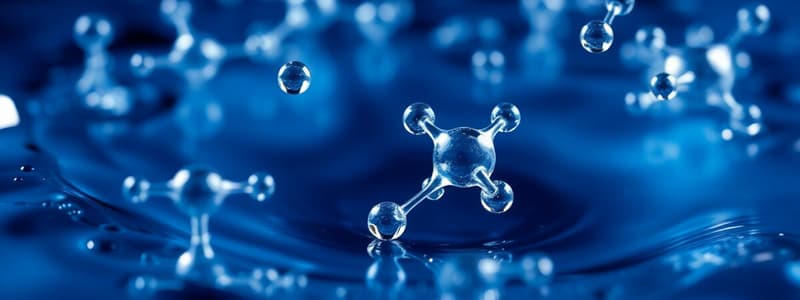Podcast
Questions and Answers
What is the primary reason for water's polar nature?
What is the primary reason for water's polar nature?
- The linear arrangement of hydrogen and oxygen atoms.
- The presence of ionic bonds between water molecules.
- The higher electronegativity of oxygen compared to hydrogen. (correct)
- The equal sharing of electrons between hydrogen and oxygen atoms.
Which term accurately describes the molecular geometry of a water molecule due to the lone pairs on oxygen?
Which term accurately describes the molecular geometry of a water molecule due to the lone pairs on oxygen?
- Linear
- Trigonal planar
- Tetrahedral
- Bent (correct)
What phenomenon primarily occurs due to the attraction between the negative dipole of an oxygen atom of one water molecule and the positive dipole of hydrogen atom of another water molecule?
What phenomenon primarily occurs due to the attraction between the negative dipole of an oxygen atom of one water molecule and the positive dipole of hydrogen atom of another water molecule?
- Hydrophobic interactions
- Ionic bonding
- Hydrogen bonding (correct)
- Covalent bonding
Which property of water is responsible for its ability to form a meniscus in a graduated cylinder?
Which property of water is responsible for its ability to form a meniscus in a graduated cylinder?
Why is the solid form of water (ice) less dense than its liquid form, which is unusual compared to most substances?
Why is the solid form of water (ice) less dense than its liquid form, which is unusual compared to most substances?
What distinguishes a molecule from an atom?
What distinguishes a molecule from an atom?
Which of the following statements accurately describes the relationship between molecules and compounds?
Which of the following statements accurately describes the relationship between molecules and compounds?
What type of chemical bond is formed when hydrogen and oxygen atoms combine to create a water molecule?
What type of chemical bond is formed when hydrogen and oxygen atoms combine to create a water molecule?
How does the chemical formula of hydrogen peroxide (H2O2) differ from that of water (H2O)?
How does the chemical formula of hydrogen peroxide (H2O2) differ from that of water (H2O)?
What is the geometric arrangement of atoms in a water molecule?
What is the geometric arrangement of atoms in a water molecule?
Flashcards
What is an Atom?
What is an Atom?
The smallest unit of matter, composed of a nucleus containing protons and neutrons, surrounded by shells of negatively charged electrons.
Covalent Bond
Covalent Bond
A chemical bond formed when atoms share electrons.
What is a Compound?
What is a Compound?
A molecule formed when two or more different types of atoms bond together.
What is a Molecule?
What is a Molecule?
Signup and view all the flashcards
Ionic Bond
Ionic Bond
Signup and view all the flashcards
Polar molecule
Polar molecule
Signup and view all the flashcards
Hydrogen bonding
Hydrogen bonding
Signup and view all the flashcards
Adhesion
Adhesion
Signup and view all the flashcards
Cohesion
Cohesion
Signup and view all the flashcards
Specific heat
Specific heat
Signup and view all the flashcards
Study Notes
Molecules and Water
- Molecules: Formed by atoms bonded together. Atoms are the fundamental units of matter, comprised of a nucleus (protons and neutrons) surrounded by a cloud of negatively-charged electrons.
- Bonding: Two main types:
- Ionic bonds: Electrons are transferred between atoms.
- Covalent bonds: Electrons are shared between atoms.
- Compounds: A type of molecule where different elements' atoms are bonded together.
- Molecule vs. Compound Examples:
- Ozone (O₃): A molecule but not a compound (same element).
- Carbon dioxide (CO₂): Both a molecule and a compound (different elements).
- Water (H₂O): A molecule and a compound. Consists of one oxygen and two hydrogen atoms. A water molecule contains two hydrogen atoms bonded to one oxygen atom via covalent bonds.
- Hydrogen Peroxide (H₂O₂): Similar to water but has two oxygen atoms, thus different properties than water (two oxygen, two hydrogens).
- Chemical Formulas: Represent the composition and quantity of atoms within a molecule (e.g., H₂O, H₂O₂).
- Water Properties:
- Molecular Geometry: Bent structure (104.5° angle).
- Polarity: Uneven electron sharing creates a dipole moment with a partial negative charge on the oxygen and partial positive charges on the hydrogen atoms.
- Polarity Interactions: Water's polarity allows it to interact with other charged molecules (hydrophilic).
- Hydrogen bonding: The attraction between the partial positive charge of hydrogen atoms in one water molecule and the partial negative charge of oxygen atoms in another. An important aspect governing many of water's properties.
- Adhesion/Cohesion:
- Water bonds with other substances (adhesion).
- Water bonds with itself (cohesion). Both are essential outcomes of hydrogen bonding.
- Water Density: Ice is less dense than liquid water due to the crystal structure caused by hydrogen bonding - a striking exception to typical solid/liquid density relationships.
- High Specific Heat Capacity: Water absorbs significant energy without a large temperature change. This stabilizes aquatic environments.
- Universal Solvent: Water dissolves many polar substances, facilitating various biological processes.
Water's Importance
- Essential for life: Critical for numerous biological functions in organisms.
Studying That Suits You
Use AI to generate personalized quizzes and flashcards to suit your learning preferences.




